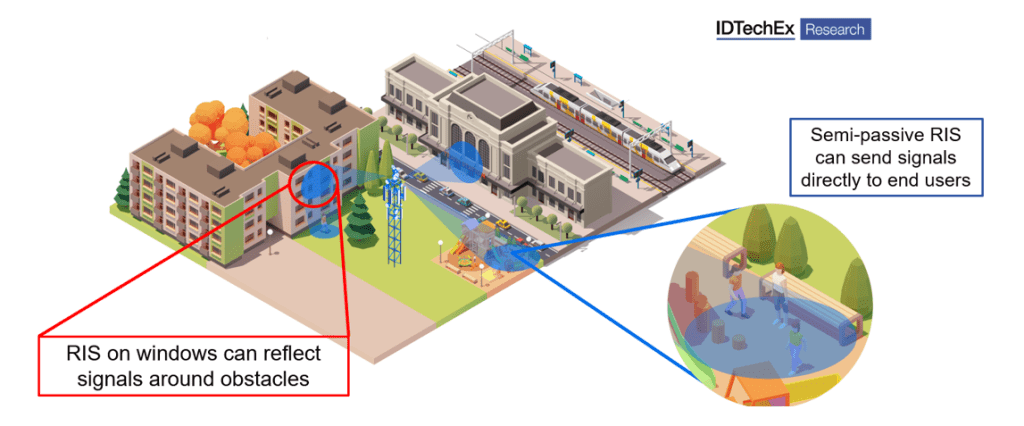Having been largely confined to the realm of academia for many years, metamaterials are now set for commercialization in several major applications. The IDTechEx report, “Metamaterials Markets 2023-2043: Optical and Radio-Frequency”, explores the opportunities within this emerging materials technology.
A particularly significant emergent application of electromagnetic metamaterials is in supporting the deployment of high-frequency telecommunications, such as millimeter wave (mmWave) 5G and even THz. High frequencies can allow for faster data transfer and hence improved user experience. However, at high frequencies, there is a severe loss in energy across long distances. These problems can be further exacerbated by obstacles, as is common in urban environments. As a result, a low-power device that can facilitate the delivery of high-frequency signals in crowded environments is required. Metamaterials offer a potential solution through enabling the development of “Reconfigurable Intelligent Systems”, or RIS for short. These systems integrate electronic components to reflect radio waves in specific, configurable directions – enabling signals to be reflected around obstacles, thus overcoming the issues of signal blockage. RIS can potentially even track users autonomously for directed communications, allowing for greater signal quality and improved security by reducing the likelihood of connection by unauthorized users. These advantages that RIS propose have drawn attention from telecom providers such as Verizon, who partnered with RIS-developer Pivotal Commware in 2020 to deploy the latter’s products in supporting mmWave 5G deployment.

If beaming a signal in a specific direction were the only goal, then this could be achieved using conventional relay stations. However, RIS offers two crucial advantages – namely, their low power use and small form factor. This allows them to be deployed at scale in areas where a conventional relay station would not fit, such as above traffic lights at crowded junctions or under a ceiling in a stadium, significantly improving 5G coverage in crowded environments. The requirement of low power also greatly reduces the costs of operating a widespread network, and it may even be possible to power some RIS devices from built-in energy harvesting systems such as solar photovoltaics.
Deployment at scale for RIS would only be possible if each device could be produced affordably – as such, the materials used and manufacturing process are of key concern. RIS developers, such as Greenerwave and Pivotal Commware, have thus designed their devices to be compatible with conventional PCB components and manufacturing methods. That these rely on well-founded industries ensures manufacturing can be carried out affordably at scale.
The devices discussed above incorporated electronic components to actively steer signals; however, electronic components are not a prerequisite. A feature central to metamaterials is their ability to reflect at otherwise unachievable angles, and so may conceivably be deployed as “mirrors” to passively reflect signals around corners. Transparent metamaterial sheets capable of this functionality pose a significant materials opportunity, as they may be integrable with existing structures such as windows or walls. An example of such a product is demonstrated by Meta Materials Inc and Sekisui, who entered a collaboration in 2021 to develop a transparent conductive reflector film that can reflect signals for improved mmWave signal coverage.
Thus far, only reflection has been considered – however, metamaterials can also enhance high-frequency telecommunications through improving the transmission of signals through windows. Low-emissivity glass contains a very thin transparent layer of metal oxide to block UV and infrared radiation; such glass can be found in the windows of regular households, businesses, and in the windshields of cars. It is becoming increasingly common for consumers to choose low-emissivity glass in order to improve energy efficiency and minimize utility bills. However, these also have the effect of blocking wireless communication signals and thus causes poor phone reception. By incorporating a transparent metamaterial film, the strength of high-frequency signals within buildings can be greatly enhanced. Indeed, such high-frequency signals experience particularly significant attenuation and may necessitate metamaterials for any viable indoor phone reception.
5G has been commercialized since 2019, but to date, mmWave has been impeded by the high costs necessary for implementation. The short range of mmWave requires large numbers of base stations to be installed, thus making it expensive and unattractive. However, metamaterial-based RIS may be set to revolutionize the market by enabling affordable, widespread coverage, paving the way for future high-frequency telecommunications. In the IDTechEx report “Metamaterials Markets 2023-2043: Optical and Radio-Frequency”, the potential of metamaterial-based RIS is analyzed in depth to assess the potential for this emergent technology in supporting high-frequency telecommunications.
Building, Design and Construction Magazine | The Choice of Industry Professionals





